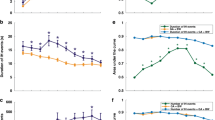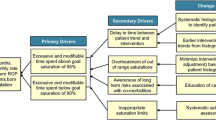Abstract
OBJECTIVE: To determine if practices related to the use of pulse oximetry in the first 2 weeks following birth and after 2 weeks of age have a relationship to the rate of retinopathy of prematurity (ROP) and retinal ablation surgery in infants ≤1500 g.
STUDY DESIGN: A questionnaire was mailed in July 2001 to 318 neonatal intensive care units (NICUs) in the United States and information was collected regarding SpO2 guidelines and the rate of both severe ROP and retinal ablation surgery.
RESULTS: A total of 142 surveys were returned (45%). In all, 87% of the NICUs had SpO2 guidelines, and 60% of these centers maintained a different range of SpO2 for infants ≤ or >2 weeks of age. The range of SpO2 was 82 to 100% with an average minimum (min) and maximum (max) of 89 and 95%, respectively. In the NICUs with an SpO2 max of >98% in the first 2 weeks following birth, the rate of retinal ablation surgery was 5.5 vs 3% in those units with a max SpO2 >98% (p<0.05). After 2 weeks of age, the rate of retinal ablation surgery was 3.3% when max SpO2 was >92 vs 1.3% when the max SpO2 was ≤92% (p<0.00001). The rate of ≥stage 3 ROP after 2 weeks of age was 5.5% when max SpO2 was >92 vs 2.4% when max SpO2 was ≤92% (p<0.0005).
CONCLUSION: NICUs in the US today have a wide range of SpO2 guidelines. The results of this survey show a “gradient of risk” towards less retinal ablation surgery when the max SpO2 is <98% in the first 2 weeks following birth (p<0.05). There was a statistically significant lower rate of ≥stage 3 ROP and retinal ablation surgery when the max SpO2 was ≤92% after the first 2 weeks of age. A randomized, controlled trial is needed to establish a safe upper limit of SpO2 in the premature infant at risk for developing ROP.
This is a preview of subscription content, access via your institution
Access options
Subscribe to this journal
Receive 12 print issues and online access
$259.00 per year
only $21.58 per issue
Buy this article
- Purchase on Springer Link
- Instant access to full article PDF
Prices may be subject to local taxes which are calculated during checkout



Similar content being viewed by others
References
Palmer EA, Flynn JT, Hardy RJ, et al. Incidence and early course of retinopathy of prematurity. The Cryotherapy for Retinopathy of Prematurity Cooperative Group. Ophthalmology 1991;98:1628–1640.
Phelps DL . Part three retinopathy of prematurity. In: Fanaroff AA, Martin RJ, editors. Neonatal–perinatal Medicine Diseases of the Fetus and Infant. 7th ed. MO: Mosby; 2002. p. 1595–1602.
Gunn TR, Eastdown J, Outerbridge EW, Aranda JV . Risk factors in retrolental fibroplasia. Pediatrics 1980;65:1096–1100.
Bedrossian RH, Carmichael P, Ritter A . Retinopathy of prematurity (retrolental fibroplasia) and oxygen: part 1. Clinical study: part II. Further observations on the disease. Am J Ophthalmol 1954;37:78–86.
Kinsey VE . Retrolental fibroplasia: cooperative study of retrolental fibroplasia and the use of oxygen. Arch Ophthalmol 1956;56:481–543.
Flynn JT, Bancalari E, Bawol R, et al. Retinopathy of prematurity. A randomized, prospective trial of transcutaneous oxygen monitoring. Ophthalmology 1987;94:630–638.
Flynn JT . Retinopathy of prematurity. Pediatr Clin North Am 1987;34(6):1487–1516.
Hunter DG, Mulcai S . Retinopathy of prematurity: pathogenesis, diagnosis and treatment. Int Ophthalmol Clin 1992;32(1):163–184.
Pierce EA, Avery RL, Foley ED, et al. Vascular endothelial growth factor/vascular permeability factor expression in a mouse model of retinal neovascularization. Proc Natl Acad Sci USA 1995;92:905–909.
Alon T, Hemo I, Itin A, et al. Vascular endothelial growth factor acts as a survival factor for newly formed retinal vessels and has implications for retinopathy of prematurity. Nat Med 1995;1:1024–1028.
Dorey CK, Aouididi S, Reynaud X, Dvorak HF, Brown LF . Correlation of vascular permeability factor/vascular endothelial factor with extraretinal neovascularization in the rat. Arch Ophthalmol 1996;114(10):1210–1217.
Penn JS, Henry MM, Wall PT, Tolman BL . The range of paO2 variation determines the severity of oxygen-induced retinopathy in newborn rats. Invest Ophthalmol Vis Sci 1995;36:2063–2070.
Flynn JT, Bancalari E, Snyder ES, et al. Cohort study of transcutaneous oxygen tension and the incidence and severity of retinopathy of prematurity. N Engl J Med 1992;326(16):1050–1054.
Vijayakumar E, Ward GJ, Bullock CE, Patterson ML . Pulse oximetry in infants of <1500 gm birth weight on supplemental oxygen: a national survey. J Perinatol 1997;17(5):341–345.
Hussain N, Clive J, Bhandari V . Current incidence of retinopathy of prematurity, 1989–1997. Pediatrics 1999;104(3):e26–33.
Brockway J, Hay WH . Prediction of arterial partial pressure of oxygen with pulse oxygen saturation measurements. J Pediatr 1998;133(1):63–66.
Tin W, Milligan DWA, Pennefather P, Hey E . Pulse oximetry, severe retinopathy, and outcome at one year in babies of less than 28 weeks gestation. Arch Dis Child Fetal Neonat Ed 2001;84:F106–F110.
Poets CF . When do infants need additional inspired oxygen? A review of the current literature. Ped Pulm 1998;26:424–428.
The STOP-ROP Multicenter Study Group. Supplemental therapeutic oxygen for prethreshold retinopathy of prematurity (STOP-ROP), a randomized, controlled trial. I. Primary outcomes. Pediatrics 2000;105:295–310.
Phelps DL, Hardy RJ, Schaffer DB, Quinn G, Gail-Summers C, Palmer EA . Gestational age and retinopathy of prematurity. Pediatr Res 1994;35:282A.
Chow LC, Wright KW, Sola A . The CSMC Oxygen Administration Study Group. Can changes in clinical practice decrease the incidence of severe retinopathy of prematurity in very low birth weight infants? Pediatrics 2003;111(2):339–345.
Saito Y, Omoto T, Cho Y, et al. The progression of retinopathy of prematurity and fluctuation in blood gas tension. Graefes Arch Clin Exp Ophthalmol 1993;231:151–156.
York J, Landers S, Kirby R, Arbogast P, Penn S . Arterial oxygen fluctuation and retinopathy of prematurity in preterm infants. Ped Res 2002;51:366A.
Thilo EH, Andersen D, Wasserstein ML, Schmidt J, Luckey D . Saturation by pulse oximetry: comparison of the results obtained by instruments of different brands. J Pediatr 1993;122(4):620–626.
Poets CF, Urschitz MS, Bohnhorst B . Pulse oximetry in the neonatal intensive care unit (NICU): detection of hyperoxemia and false alarm rates. Anesth Anal 2002;94:S41–S43.
Gerstmann D, Berg R, Haskell R, et al. Operational evaluation of pulse oximetry in NICU patients with arterial access. J Perinatol 2003;23:378–383.
International Committee for Classification of ROP. An international classification of retinopathy of prematurity. Pediatrics 1984;74:127.
International Committee for Classification of ROP. An international classification of retinopathy of prematurity. II. The classification of retinal detachment. Arch Ophthalmol 1987;105:906.
Cryotherapy for Retinopathy of Prematurity Cooperative Group. Multicenter trial of cryotherapy for retinopathy of prematurity: preliminary results. Arch Ophthalmol 1988;106:471–479.
Author information
Authors and Affiliations
Rights and permissions
About this article
Cite this article
Anderson, C., Benitz, W. & Madan, A. Retinopathy of Prematurity and Pulse Oximetry: A National Survey of Recent Practices. J Perinatol 24, 164–168 (2004). https://doi.org/10.1038/sj.jp.7211067
Published:
Issue Date:
DOI: https://doi.org/10.1038/sj.jp.7211067
This article is cited by
-
Effect of fluctuation of oxygenation on the development of severe retinopathy of prematurity in extremely preterm infants
Journal of Perinatology (2020)
-
Dose variability of supplemental oxygen therapy with open patient interfaces based on in vitro measurements using a physiologically realistic upper airway model
Respiratory Research (2019)
-
Oxygen therapy of the newborn from molecular understanding to clinical practice
Pediatric Research (2019)
-
Alarm safety and oxygen saturation targets in the Vermont Oxford Network iNICQ 2015 collaborative
Journal of Perinatology (2017)
-
Graded oxygen saturation targets and retinopathy of prematurity in extremely preterm infants
Pediatric Research (2016)



